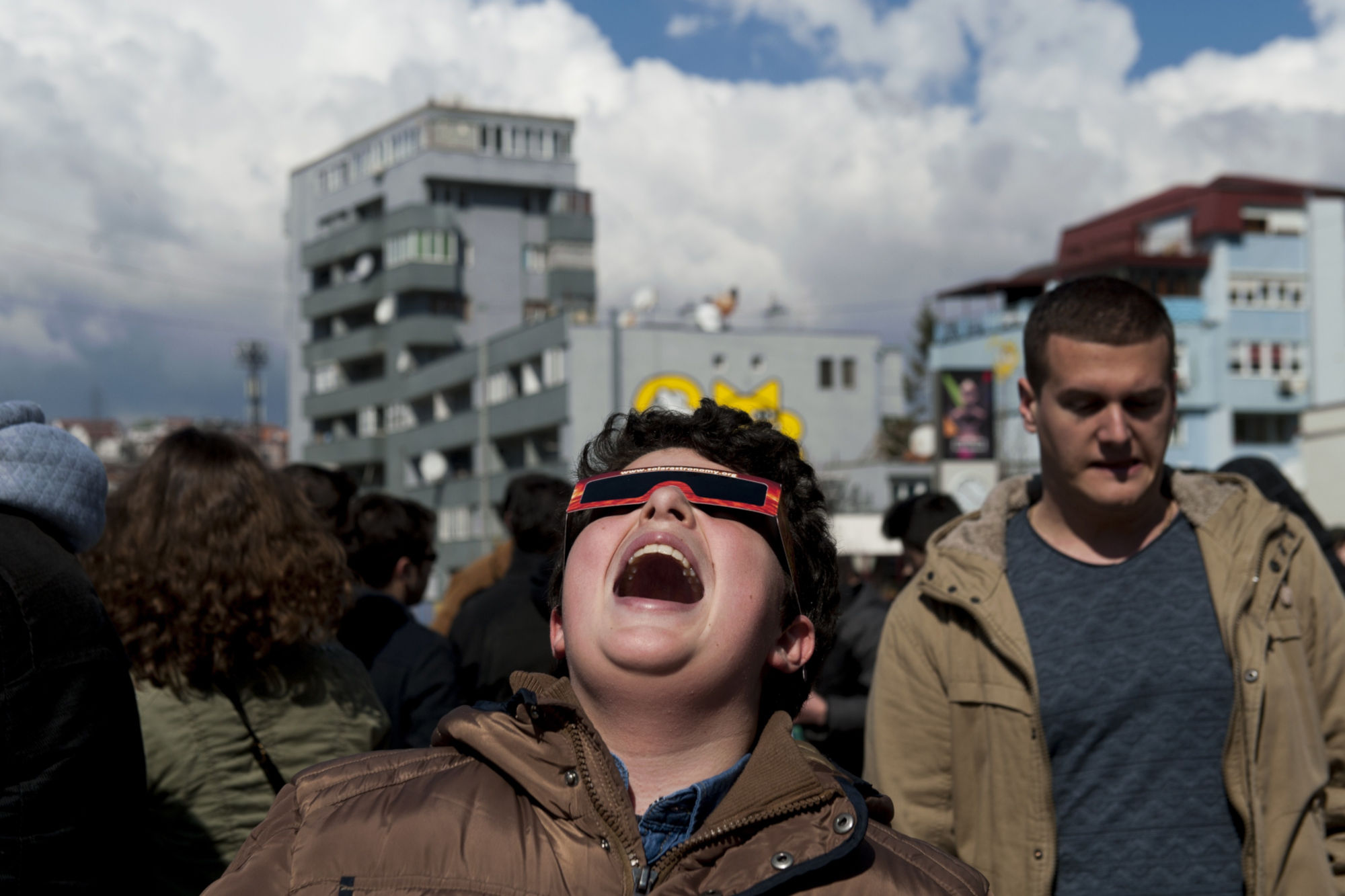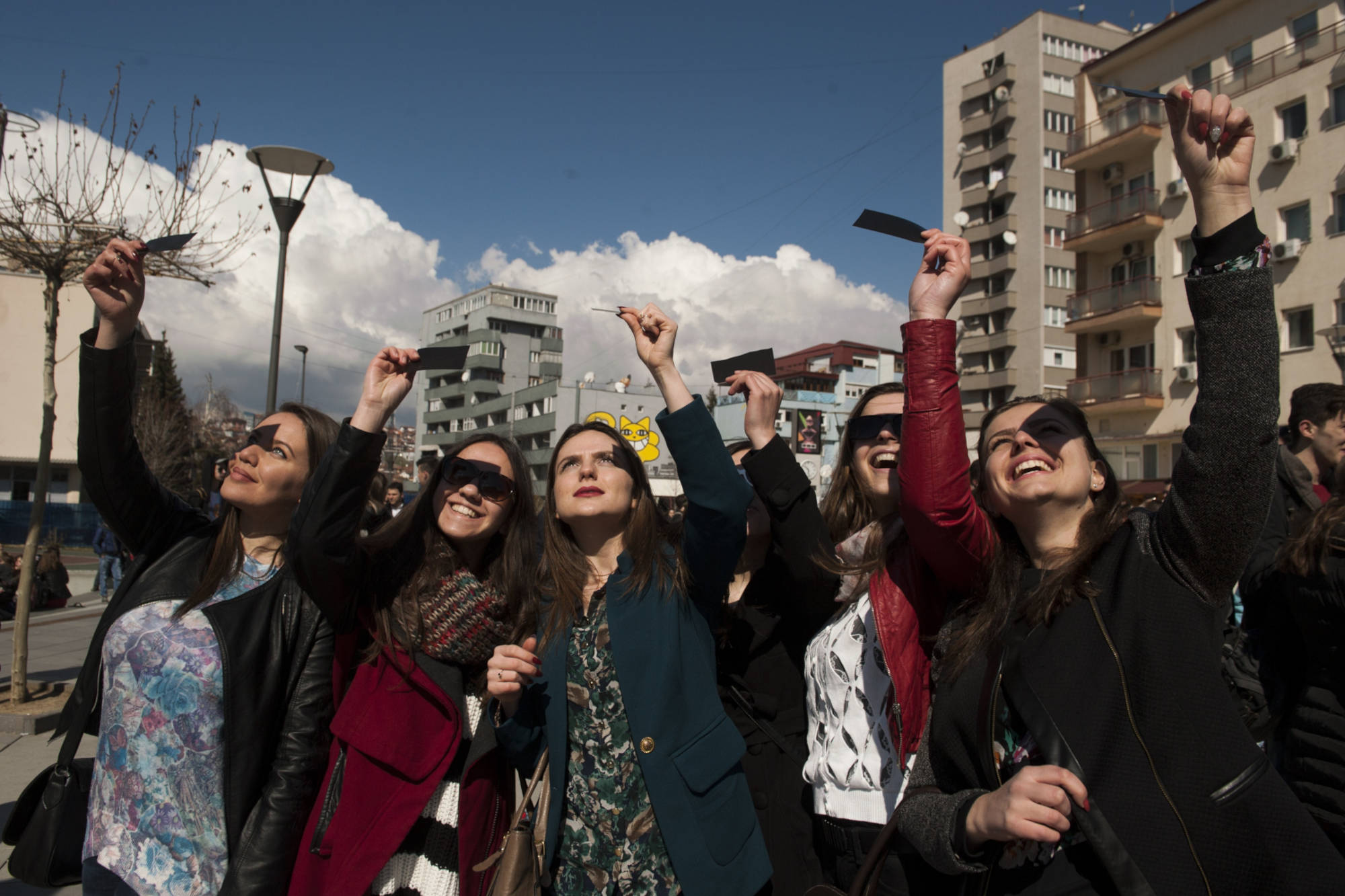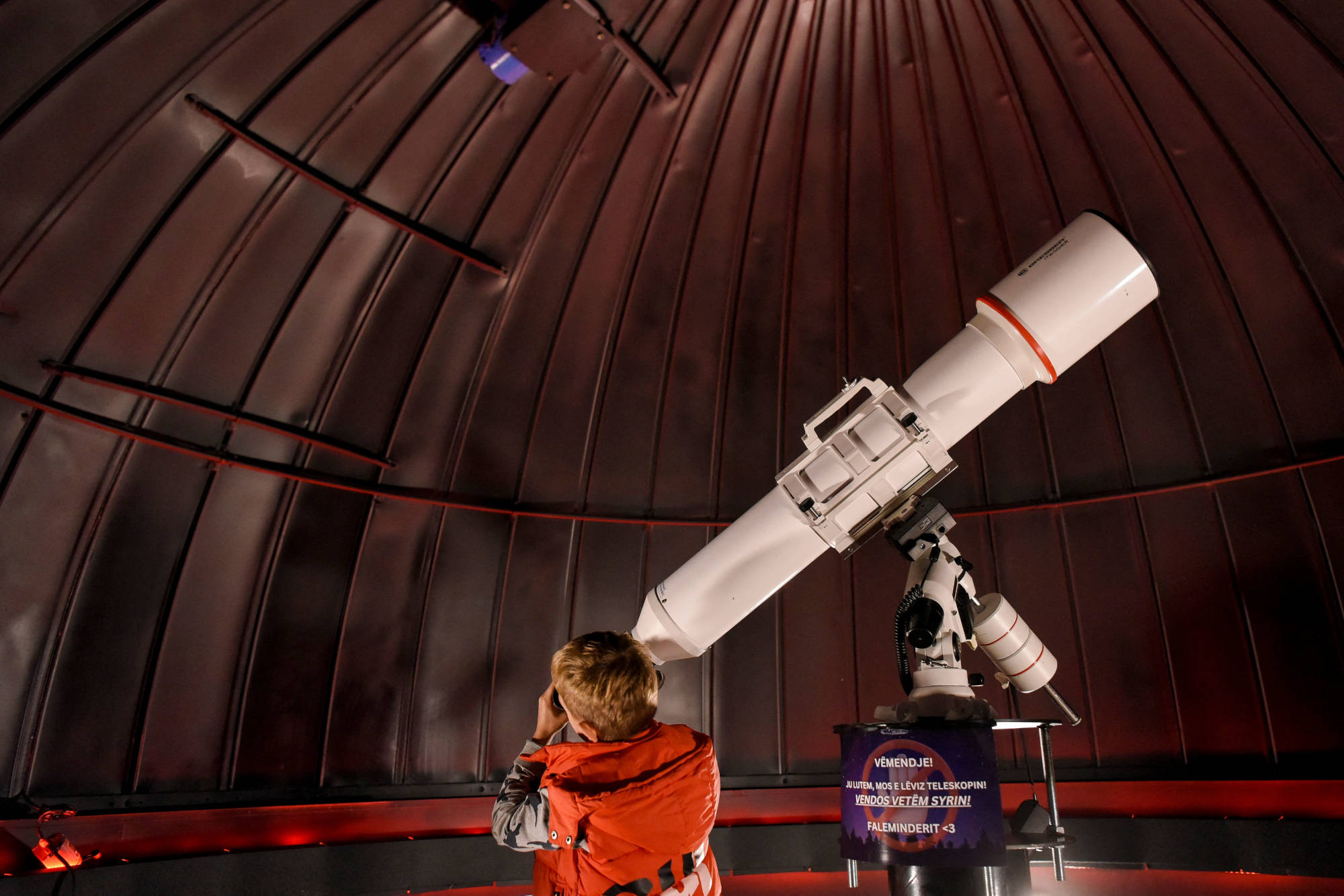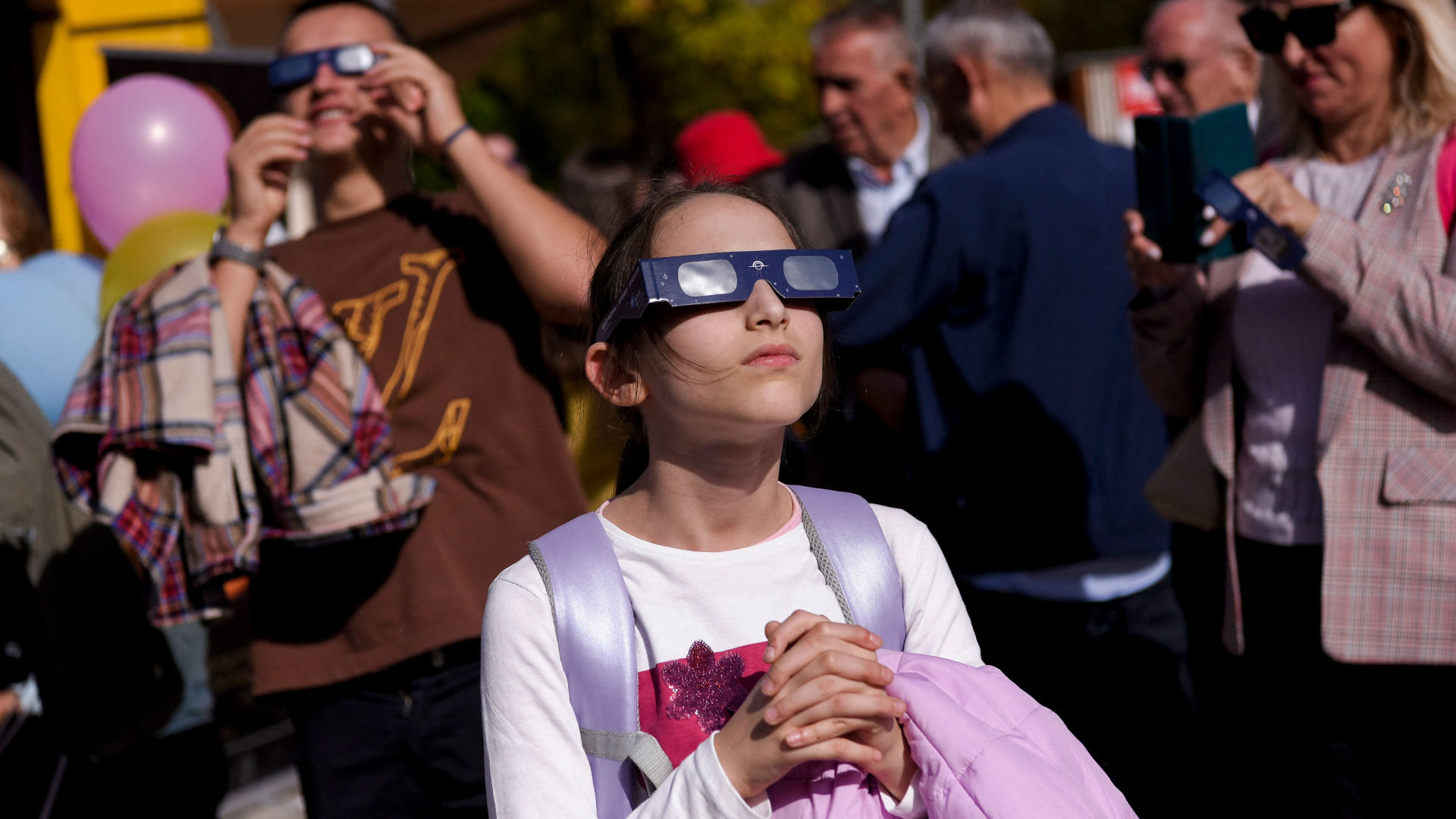In Kosovo, Stargazing for a Brighter Future
In the summer of 1999, two months after the Kosovo War had ended, Pranvera Hyseni watched the moon pass in front of the sun through a reflection cast in a red pail of water. Her grandfather had set up a homemade viewing station, and he assured Hyseni, then 3 years old, that the rare phenomenon was nothing to fear.
Bearing witness to her first full solar eclipse turned out to be “something spectacular,” she said, and the aesthetic force of the experience — the feeling of being both mystified and bowled over by the vastness of the sky and its inscrutability — held as a kind of initiation into the field of stargazing. Nearly 25 years later, Hyseni now serves as an ambassador to Astronomy Outreach of Kosovo, or AOK, a nonprofit she founded to give young people a chance to experience that feeling firsthand.
In recent years, astronomy enthusiasts such as Hyseni have helped drive the development of science infrastructure in Kosovo, a young Balkan country still finding its bearings following a bitter war. Those grassroots efforts have helped spur the establishment of the country’s first science center, the re-opening of a long-dormant observatory in the capital, and plans for a new natural science and mathematics building at the University of Prishtina, Kosovo’s largest public university. But the country continues to struggle with issues such as brain drain, a weak education system, and ongoing ethnic tensions.
Many science advocates and some government officials in Kosovo regard STEM education and scientific infrastructure as a key component of societal and state growth. Their strategy parallels that of other developing countries eager to see the opportunities flow from improvements in the science sector. Post-apartheid, South Africa invested in the Southern African Large Telescope, or SALT, now the largest single optical telescope in the Southern Hemisphere. In 2012, Ethiopia established the Entoto Observatory and Space Science Research Center with the promise that it would bring a host of benefits to various aspects of society, including the economy, the health care system, and education.
In countries where funds are limited, such developments have been critiqued for their seeming extravagance: For example, with SALT, “people asked why do we want to build such a big telescope, for lots of money, when we’ve got all these challenges that we need to address,” said Kevin Govender, who directs of the South Africa-based Office of Astronomy for Development, an organization that aims to further the use of astronomy as a tool for development. But he said that the telescope has far-reaching benefits, helping with “everything from stimulating high-tech industries to educational outreach aspects to development of astronomy tourism in the region of the observatory.”
“We should be trying to compete scientifically and technologically with other countries, not just sit there and wait for other people to save us in some way.”
There is some evidence to back this up in the U.S.: A 2013 report from the Brookings Institution, a Washington, D.C.-based think tank, noted that cities with a higher concentration of STEM-based workers — those with a background in science, technology, engineering, and math — had higher job growth, employment rates, and wages. And experts have advocated for the promotion of STEM education globally. A 2022 United Nations policy paper recommends the use of STEM education as “an enabler for development and peace,” and investing in STEM opportunities for girls has long been seen as a key tool to addressing gender inequality.
Many astronomy enthusiasts, like Hyseni, want to see better opportunities in scientific fields for Kosovars at home. “We should be trying to compete scientifically and technologically with other countries, not just sit there and wait for other people to save us in some way,” she said. And stargazing, enthusiasts say, might be a means to that end.
“Astronomy is a field that inspires people,” Govender said. “It stimulates curiosity, and in that way, it’s seen as a gateway science.”
In 2008, Kosovo declared independence from Serbia, nearly a decade after the brutal war with the Federal Republic of Yugoslavia (now Serbia and Montenegro) had ended. The country is still reeling from the effects of the conflict, which has required a focus on building basic state infrastructure in the form of reliable electricity, schools, roads, and jobs. In the meantime, however, it has added science to the agenda.
In 2014, Hashim Thaçi, Kosovo’s prime minister at the time, spoke of the need to support innovation in science and technology. More recently, the current prime minister, Albin Kurti, promised to prioritize science, which he sees as central to the country’s economic advancement. In a speech in April, he said that the National Science Program — a wide-ranging five-year plan to build up the country’s scientific research infrastructure and bring science education and research up to global standards — would aim to “generate sustainable jobs and develop the country’s economy based on knowledge, expertise, scientific achievement, and technological innovation.” (The plan has since been approved.)
Though the country has voiced support and, more recently, increased funding for scientific endeavors, large-scale investments for science have historically been limited, prompting some citizens, such as Hyseni, to take the lead.
While Hyseni’s curiosity about the skies was sparked by that first solar eclipse, another eclipse in 2015 became the impetus for AOK’s first large-scale outreach event, only a month after its founding. Using equipment donated from around the world, including a host of dedicated solar telescopes and hundreds of solar glasses, Hyseni went to the capital’s most frequented district to “give access to people to view the eclipse in a safe way.”
Over 1,000 people showed up to the event in the main square of the capital, Prishtina (also often spelled as Pristina). The gathering remains one of the organization’s most successful activities to date. It also connected Hyseni to others who shared her interest, including Milaim Rushiti, who teaches astronomy and physics at a natural science high school, and now directs the organization.
Around the same time that AOK was formed, another organization with a similar name and mission was emerging: The Astronomy Club of Kosova, shortened to ACK, was founded in 2014 by a group of astronomy enthusiasts who wanted to encourage young people to pursue fields in STEM while making the field of astronomy more accessible. Like AOK, ACK puts on workshops and educational sessions to provide students with practical knowledge of the cosmos. ACK focuses on bringing astronomy to groups underrepresented in science. Today, the group boasts almost 1,000 members, about 80 percent of whom are women and girls.
The director, Suhel Ahmeti said he wants to promote astronomy “as a culture, not just as a scientific field.” Among ACK’s greatest successes has been the re-opening of the Prishtina Observatory, which had been closed to the public for over three decades, a relic of the era when Kosovo was still a part of former Yugoslavia. The group now runs the observatory, and the one-euro entry fee helps support maintenance costs.


Access appears to be a motivating feature of grassroots science infrastructure efforts in Kosovo. Hyseni, Rushiti, and Ahmeti all noted they had little exposure to astronomy curriculum in their K-12 education, and the subject is only offered as a required course in natural science high schools. Telescopes are also hard to come by. Even as someone trained to teach physics and astronomy, Rushiti did not have access to a telescope at university. He was in his early 30s the first time he looked through one.
Meanwhile, no university in Kosovo has an astronomy department, which means that students who want an advanced degree in the field have to leave the country to do so. Many end up studying adjacent subjects, like physics, instead. Hyseni, for example, pursued a bachelor’s degree in geography, which she thought was the closest she could get to planetary science. Now she is pursuing a Ph.D. in earth and planetary sciences at University of California, Santa Cruz.
Rushiti said he sees organizations such as AOK as providing opportunities his generation didn’t receive: “We’re making it appealing to those who can study it, because my time is up.” But small organizations doing education outreach often run into difficulties. With frequent travel across long distances, groups such as ACK and AOK need ample and steady funding. Volunteers, meanwhile, have to haul sensitive instruments across the country, which risks damaging the equipment.
With these accessibility issues in mind, Hyseni and her team petitioned the government in 2019 for support to build Kosovo’s first science center, which, she admits, was “a longshot,” but one they figured was worth a try. An idea that began with a modest plan to build an observatory ballooned into a sprawling space that would include a telescope control room, a planetarium, and STEM exhibitions.

In collaboration with architects, as well as international contacts — including scientists, astronomers, and engineers — that Hyseni and her team had met through years of outreach, they drew up their design plans. To reduce costs and increase the likelihood of the proposal’s approval, Rushiti donated his own land to the cause. The site, which is located in a town about 18 miles from the capital, has the added benefit of low light pollution. The Kosovo parliament approved AOK’s proposal unanimously in February 2019, but the government delayed disbursing the funds.
When asked about the delay, Bora Shpuza, chief of cabinet at the Ministry of Education, Science, Technology, and Innovation, or MESTI, said that she could not address details for why those specific funds were delayed, but that “it stands to reason that the allocation of funds takes time, like every process of financial nature.”
About seven months later, Hyseni worried that the project would wither without the government’s financial backing. So she held a small protest on the steps of MESTI, reiterating the need for a science hub that would not only provide a place for citizens to receive access to STEM education, but enable scientists to conduct observations of celestial objects without having to leave the country. In 2022, the group received the financing — around 310,000 euros, or roughly $340,000 at the time — and construction on the science center began later that year.
Despite the state’s recent show of support, local organizations still struggle to fund their activities, often finding critical aid abroad in the form of donations and intellectual exchange. And while the government funded the construction, furnishing the science center’s interior will largely be left up to AOK. They hope to source most of the equipment through donations. The California-based company Celestron, one of the world’s largest telescope manufacturers, for example, has donated a C14 Edge HD telescope that will be fitted to the observatory. It will be Kosovo’s largest telescope.
Advocates of investment in science, innovation, and technology in developing countries tend to see it as a way to stem brain drain. In Kosovo, where around half of the population is under the age of 25, the issue is particularly pronounced given high unemployment — by some estimates, between 40 and 50 percent of young people don’t have a job. As a result, many, like Hyseni, leave the country to seek educational and economic opportunities.
“Luxury is no longer about having a car or not,” Rushiti said. “It’s about whether you can keep your child in your own country.” He believes that the development of scientific infrastructure is one way to give young people hope of finding meaningful opportunities at home.
Nkem Khumbah, now head of STI Policy Systems Governance and Partnerships at the African Academy of Sciences, believes that developing countries suffer when basic systems and structures are not in place. “The absence of infrastructure is not just the physical infrastructure,” he said. “It means that the overall ecosystem for the knowledge economy is weak and the elites, the educated, are part of the knowledge economy, and they’ll go where the knowledge economy is thriving more.”
The Kosovo government recently approved its national science agenda, which in addition to developing the country’s education and research infrastructure, also includes plans to establish a national institute of science and technology, an interdisciplinary center equipped with research labs and equipment, and which will allocate grants to support scientific endeavors.
“Luxury is no longer about having a car or not. It’s about whether you can keep your child in your own country.”
Today, a little over 3 percent of Kosovo’s state budget of 2.5 billion euros — more than $2.6 billion in U.S. dollars — goes to MESTI, according to an email from Arbërie Nagavci, Kosovo’s minister of education, science, technology, and innovation. While the sum is small, it is the highest to date and represents an increase of 24 percent. Encouraging women in STEM is another major part of the government’s science agenda. In 2021, MESTI allocated 1 million euros — around $1.15 million at the time — to 1,000 women enrolling in STEM programs at the university level, and doubled that amount in 2022.
Nagavci wrote that the new science resources “will enable a better understanding and appreciation of astronomy and the natural sciences, and will aid in raising a generation of scientifically literate and inquisitive individuals.”
Hyseni and other grassroots advocates consider the democratization of astronomy and science literacy as a critical part of Kosovo’s future growth. She sees the new science center as one step towards building Kosovo’s capacity to compete on a global level. “Everybody is trying to do something great so that we can have a great country,” Hyseni said. “We can have good science. We can have supportive systems and all of that so that people can have a better life in the future.”
While the science center is scheduled to open in May 2024, the AOK is already receiving calls from schools looking to schedule visits with their students.
Note: The author conducted some interviews for this story in Albanian and translated them to English.
Suzana Vuljevic is a writer, editor, and translator whose work has appeared in Artforum, Eurozine, Harvard Magazine, and Words Without Borders, among other outlets. She holds a Ph.D. in history and comparative literature from Columbia University.











